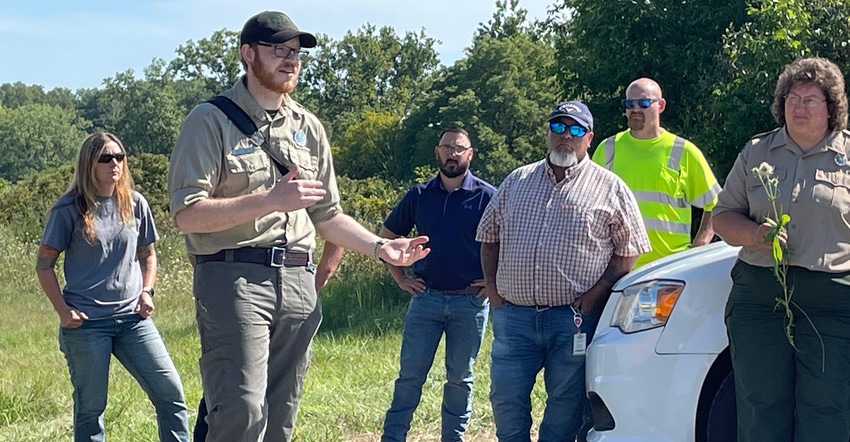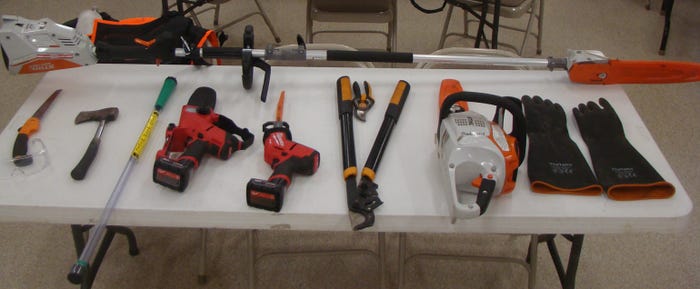October 13, 2022

In today’s world, it’s more rule than exception to wake up one day and realize that one or more invasive plant species have invaded your farming operation. These troublemaking squatters were frequently introduced with good intentions, but with no natural predators, they have taken over many woodlands, fencerows, wetlands and pastures. Left unchecked, they do serious damage.
It might appear these invaders have already won. But a multi-agency field day held at Salamonie River State Forest in Indiana brought good news. While it takes effort, it’s a winnable war. And it’s worth the effort.
Here are 10 tips for dealing with invasives:
1. Realize help is available. Multiple agencies are eager to help you address your problem. Purdue Extension and county soil and water conservation districts are good resources. Also, the State of Indiana Cooperative Invasives Management group (SICIM) exists to help landowners, municipalities and others deal with invasives. Learn about scheduling a free landowner survey and SICIM recommendations at sicim.info.
2. Know your enemy. The first step is to know what species you have. Smartphone apps can help identify them. Dugan Julian, SICIM’s northeast Indiana regional specialist, uses iNaturalist, LeafSnap and his favorite, PlantNet.
3. Make a plan. The Department of Natural Resources’ Justin Emmons, assistant manager at Salamonie River State Forest, suggests these planning steps: First, know what species of invasives you have. Second, review different courses of action, such as chemical, mechanical or other. Third, execute those actions. Finally, follow up to see if the actions were effective and modify your plan accordingly.
4. Get timing right. “Whether you ran a car into a brick wall at 65 miles per hour or 3 miles per hour would make a huge difference in the damage to your car,” says Geoff Schortgen, Purdue Extension, Wabash County, Ind. “The same applies to applying herbicides in a timely manner. If you hit them when they’re at their most vulnerable — small, green and growing rapidly — your efforts will be much more effective.”
5. Consider machines for large infestations. Emmons says for very large-acreage infestations or if invasives are small trees, using a forestry mulcher or track loader can make short work of the problem. Follow up later when invasives resprout. Machines are available to rent, or you can hire a contractor.

6. Attend a “weed wrangle.” These events are learning experiences where volunteers gather at an announced site to clear out invasive species. Each event includes an educational component. To find a weed wrangle, visit sicim.info.
7. Control poison hemlock. One invasive gaining momentum is poison hemlock. A highly toxic plant that can cause mild to serious skin inflammation in people, it can kill animals that eat it in a pasture. Schortgen says April and early May is a good time to scout for this biennial. Spraying it in its first year is effective. In its second year, it flowers and becomes more toxic. “Be very careful when dealing with poison hemlock,” Schortgen says. “I would not attempt to mow it without having a climate-controlled cab on my tractor.”
8. Be persistent. “Invasives are here to stay, and there’s no silver bullet,” Schortgen says. “But we have so much more awareness than 15 years ago, and much more help available. Once you get them cleaned out for the first time, the problem becomes much easier to manage.”
9. Educate others. Get your neighbors to act. “We can fight invasives on individual properties, but if they’re still in the area, they can get dragged back onto your property,” Emmons says. “If everyone addresses invasives, it makes it a lot easier for everyone to manage.”
10. Obtain good tools. Having the right tools can make fighting invasives easier and more effective. Useful tools include a telescoping pole trimmer, weed wand, safety glasses and protective gloves for handling herbicides.
Boone writes from Wabash, Ind.
About the Author(s)
You May Also Like






